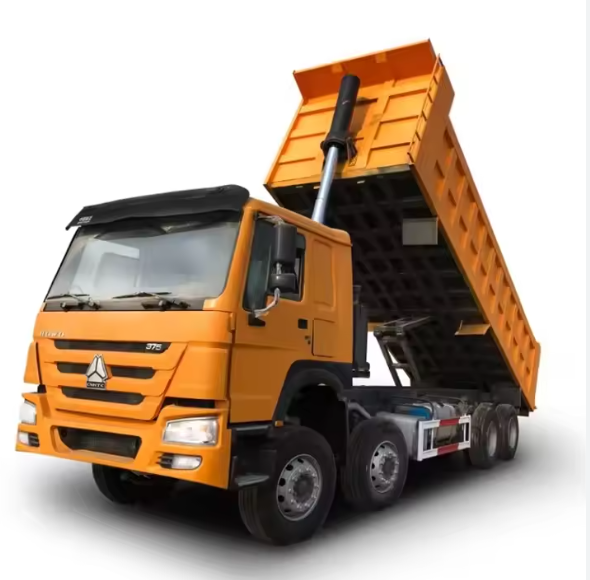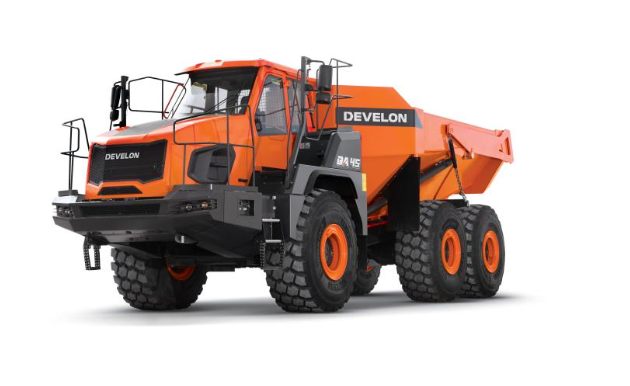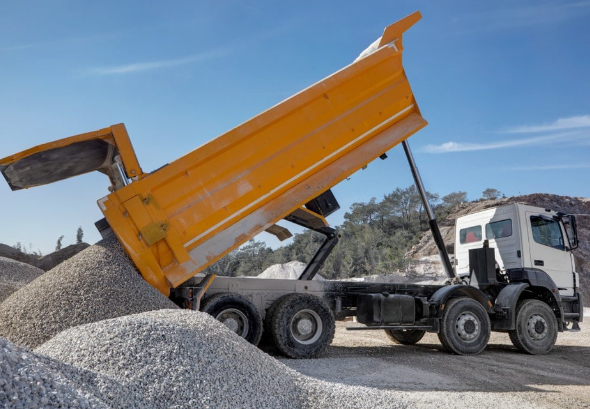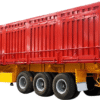If you’ve ever tackled a landscaping or construction project, you’ve probably wondered, “How many yards of gravel can a dump truck actually hold?” I’ve asked myself the same question—especially when planning deliveries for my own jobs. The answer isn’t as straightforward as you might think, because dump trucks come in different sizes, and gravel weight plays a big role. Let me break down what I’ve discovered from experience and research.
From my time working on home improvement projects, I’ve learned that most standard dump trucks can carry between 10 to 20 cubic yards of gravel. But here’s the catch—smaller trucks (like a single-axle dump truck) might only handle 6 to 8 yards, while larger tri-axle models can haul 20+ yards. The exact amount depends on the truck’s bed size and weight limits, which I’ll explain in more detail.
One thing that surprised me early on was how gravel density affects capacity. Even if a truck can hold 14 cubic yards, heavier gravel types (like dense river rock) may force you to reduce the load to stay under legal weight limits. After a few miscalculations, I realized that knowing your gravel’s weight per yard is just as important as measuring volume. Let’s dive into the specifics so you can plan your next project with confidence.
Standard Dump Truck Capacity
From my experience, a standard dump truck can carry 10 to 16 cubic yards of material. The exact amount depends on the truck’s make, model, and size. You’ll find most full-size models handle 10 to 14 cubic yards.
Calculating Dump Truck Yardage
I suggest this method to find your truck’s exact capacity:
– Measure the bed’s length, width, and height in feet.
– Multiply these three numbers to get the cubic feet.
– Divide that total by 27. This converts it to cubic yards.
Example:
Let’s say your truck bed measures 14 ft × 6 ft × 5 ft. This equals 420 cubic feet. When you divide 420 by 27, you get 15.56 cubic yards.If you measure in inches, multiply the measurements and divide by 46,656 to get the yardage.
Material Weight and Load Limits
- For lighter materials like dirt, I’ve found you can fill a standard dump truck with 10–14 cubic yards per load.
- Be careful with heavier materials like gravel. You need to check the weight limits. For reference, one cubic yard of gravel weighs about 3,000 pounds.
- A larger truck might haul up to 16 cubic yards or 15 tons (30,000 pounds). I recommend you always check your truck’s Gross Vehicle Weight Rating (GVWR).
Dump Truck Dimensions and Types
- A standard dump truck holds 10–16 cubic yards.
- You’ll find smaller dump trucks built on pickup frames. These carry a few cubic yards or half a ton.
- For tough loads like demolition debris, I suggest using a truck with a reinforced frame.
Key Points
- I always recommend checking your truck’s manual for its specific capacity.
- Do not exceed the manufacturer’s stated weight and yardage limits.
- Your truck’s capacity depends on both the volume and the weight of the load. With heavy materials, you will hit the weight limit before you fill the bed to its maximum cubic yards.
Super Dump Truck Capacity
From my experience, a super dump truck is built to move much more material than a standard one. For big gravel projects, I find these trucks are highly efficient and get the job done faster.https://www.youtube.com/watch?v=fqc3TV3myZI
How Much Gravel Can a Super Dump Truck Carry?
- Capacity Range: A super dump truck hauls 14 to 16 cubic yards of gravel in one load.
- Weight Limits: Gravel weighs around 3,000 pounds per cubic yard. This means a loaded super dump can haul up to 48,000 pounds (24 tons) in one trip.
- Bed Dimensions: I think their bed design is very smart. It’s made to carry the maximum amount of gravel legally allowed by DOT axle weight rules.
Super Dump vs. Standard Dump Truck
- Standard models: These handle 10–12 cubic yards.
- Super dump trucks: They handle larger loads of 14 to 16 cubic yards per trip.
- Specialty trucks: Some trucks, like articulated ones, can carry over 25 yards. I’ve noticed they aren’t used as often for everyday construction jobs.
Real-World Applications
- Highway Construction: On highway projects, a super dump delivers 16 cubic yards per run. This means fewer trips, which saves a lot of time.
- Subdivision Development: To move 160 cubic yards, a super dump can do it in just 10 loads. A standard 10-yard truck would need 16 trips for the same work.
Key Benefits of Using a Super Dump Truck
- More Efficient: You’ll make fewer trips on big jobs.
- Load Example: To help you picture it, I think of each load as 16 large blocks. Each block is about 3 ft × 3 ft × 3 ft, which is one cubic yard.
- Best For: I recommend them for commercial roadwork. They are also great for large site prep and any job needing bulk material transport.
Tip: I suggest you always check the specific truck’s weight limits. Look at the manufacturer’s specs. Most super dump trucks I see carry 14–16 cubic yards of gravel per load.
Articulated Dump Truck Gravel Capacity
From my experience, articulated dump trucks are your best bet for tough, off-road jobs. They are built for stability and easy steering on difficult ground. For moving gravel, these trucks are impressive. They can haul about 25 cubic yards in one load. I recommend them for big projects where a standard or super dump truck just won’t cut it.
Key Capacity and Usage Details
- Maximum Capacity: 25 cubic yards of gravel per load
- Weight Limit: Gravel weighs around 3,000 pounds per cubic yard. A full load can reach up to 75,000 pounds.
- Comparison: To give you some perspective, standard dump trucks hold 10–12 cubic yards. Super dump trucks handle a bit more, at 14–16 cubic yards.
Best Uses for Articulated Dump Trucks
I’ve seen these trucks used most in these situations:
- Large Construction Sites: They are perfect for major building or site development jobs.
- Mining Operations: Mines often use them because of the rugged terrain and large amount of material.
- Remote or Rugged Infrastructure Projects: I find they are ideal for remote projects where traditional trucks cannot work well.
How Do Other Trucks Compare?
- Belly Dump & End Dump Trucks: You might see these trucks haul more, around 29–32 cubic yards. I’d suggest using these only for highway driving or on flat ground. They are not built for rough job sites.
Based on my experience, it’s critical to check the truck’s official specs from the manufacturer. You also need to look at the site conditions before you start hauling. Local laws or specific job rules can change how much you’re allowed to carry.
Belly Dump / End Dump Truck Gravel Capacity
From my experience, belly dump and end dump trucks are what you want for moving tons of gravel. I often see them on highways and large construction sites. They are designed to carry far more than a standard truck.
| Aspect | Details |
|---|---|
| Gravel Volume Capacity | Can carry 29 to 32 cubic yards of gravel in one load. |
| Weight per Load |
|
| How Belly Dump Trucks Work |
|
| How End Dump Trucks Work |
|
| Where These Trucks Excel |
|
| Capacity Comparison |
|
Summary:
Based on my experience, if your goal is to move the maximum amount of gravel in one trip, I suggest belly or end dump trucks. They provide the best capacity for road-legal vehicles. They can handle up to 32 cubic yards, which is about 96,000 pounds of gravel. I always advise checking the manufacturer’s specs and following local weight laws for any job.
Smaller Pickup Frame Dump Truck Capacity
I often get asked how much gravel a smaller pickup dump truck can hold. It’s important to know that these trucks are very different from the big commercial ones. Let me share what I’ve learned from my experience.
- Average carrying capacity: Most smaller dump trucks can haul about 6.5 to 7.5 tons (13,000 to 15,000 pounds).
- Cubic yard capacity: These trucks move 5 to 6 cubic yards of gravel per load. I’ve seen some models with well-designed beds get up to 7 cubic yards, but you have to check local road limits.
- Material and weight limits: With heavy stuff like gravel, I find the truck’s maximum weight rating is the real issue, not just how big the bed is. You can hit the vehicle’s legal weight rating before the bed looks completely full.
Small Dump Truck Capacity Example
- Typical small dump truck bed:
- Bed size: 8 ft (L) × 5 ft (W) × 2 ft (H)
- Volume: 8 × 5 × 2 = 80 cubic feet
80 ÷ 27 ≈ 2.96 cubic yards
- I suggest you always check the truck’s weight limits before loading. If the bed is deeper or the frame is stronger, it could hold over 5 cubic yards—but weight is key.
Key Comparison Table
| Truck Type | Typical Gravel Capacity (Cubic Yards) | Weight Limit (Tons) |
|---|---|---|
| Pickup/small frame dump truck | 5 – 6 | 6.5 – 7.5 |
| Standard single axle dump | 10 – 12 | 10 – 14 |
| Super dump | 14 – 16 | 14 – 16 |
My Safety Recommendations
- From my experience, overloading is a bad idea. Piling loose gravel above the bed walls or going over the weight limit is unsafe. It can also get you in trouble with the law.
- Wet gravel is a lot heavier than dry gravel. Keep this in mind, as it will change how much you can safely carry.
- I recommend you always check the GVWR (Gross Vehicle Weight Rating). You find it from the maker or on the truck’s official papers. This helps you calculate a safe load for both size and weight.
My Advice on Using Small Pickup Dump Trucks
In my opinion, smaller pickup dump trucks are perfect for home landscaping and DIY projects. They’re also great for small construction jobs. They can get into tight spaces and are easy to move around, which for some jobs is more important than hauling a massive amount.I hope these points give you a clear picture of what to expect. Please be mindful of the capacity and safety rules when you use a small pickup dump truck for gravel.
How to Calculate a Dump Truck’s Gravel Capacity
From my experience, knowing your dump truck’s gravel capacity is very important. It helps you plan projects better and transport materials safely. I’ve found this simple, step-by-step method helps you figure out how much gravel a dump truck can hold:
Step 1: Measure the Dump Truck Bed
- I suggest you use a tape measure. Record the inside length, width, and height of the truck bed. Make sure your measurements are in feet.
Step 2: Calculate Volume in Cubic Feet
- Multiply the bed’s length × width × height.
- Example: A bed measuring 20 ft (L) × 8 ft (W) × 5 ft (H) gives you 800 cubic feet.
Step 3: Convert Cubic Feet to Cubic Yards
- There are 27 cubic feet in 1 cubic yard. So, you should divide your total cubic feet by 27.
- Example: 800 ÷ 27 is about 29.6 cubic yards.
Step 4: Convert Cubic Meters to Cubic Yards (if needed)
- If you measured in cubic meters, just multiply that number by 1.30795. This will give you the amount in cubic yards.
- Example: 11 m³ × 1.308 is about 14.4 cubic yards.
Step 5: Factor in Material Weight and Density
- I recommend you figure out the load capacity using the material’s density. Here is the formula I use:
- Load Capacity (tons) = Bed Capacity (m³) × Material Density (tons/m³)
- Example: Let’s say gravel has a density of 2.5 tons/m³ and you have a 10 m³ truck bed. The max load is 10 × 2.5 = 25 tons.
Example Calculation: Pea Gravel
- Density: ~1788 kg/m³.
- Truck bed: 11 m³.
- Maximum load: 11 × 1788 = 19,668 kg (21.7 tons).
- Capacity in yards: 11 × 1.308 ≈ 14.4 cubic yards.
Step 6: Check Axle Limits, Legal Restrictions, and Road Conditions
You should never go over your state’s legal maximum axle load. This helps you avoid fines or damage.I also suggest adjusting the load size if the material is wet. Wet sand and gravel are a lot heavier than when they are dry.
Quick Reference Table: Typical Loads
| Material | Cubic Yards per Load | Approx. Weight per Load |
|---|---|---|
| Gravel (dry) | 8–10 yd³ | ~20–24 tons |
| Dirt (moist) | 10–12 yd³ | ~18–22 tons |
| Sand (wet) | 8–10 yd³ | ~22–26 tons |
Step 7: Estimate Number of Loads Needed
- To estimate how many loads you’ll need, I use this formula: Total Volume Needed (cubic yards) ÷ Truck Capacity (yd³) = Number of Loads
- Example: If you need to move 100 yd³ of gravel with a 10-yard truck, you’ll make 10 trips (100 ÷ 10 = 10 loads).
As a final tip, I recommend you always check the truck’s Gross Vehicle Weight Rating (GVWR) and the manufacturer’s guide for exact limits. Also, review local laws before you haul. This will help you follow the rules and prevent expensive problems.
Key Factors That Limit Gravel Capacity (Weight vs. Volume)
From my experience, two main things limit how much gravel a dump truck can haul. The first is its weight capacity (payload). The second is the volume of its bed. The real capacity is a balance between these two factors.
Weight Limits: The Primary Restriction for Gravel
The Gross Vehicle Weight Rating (GVWR) is the most important number. It tells you the maximum total weight allowed for the truck and its load combined.I recommend calculating the payload like this: Subtract the truck’s empty (curb) weight from its GVWR.Example: A dump truck has a GVWR of 26,000 pounds. Its curb weight is 13,000 pounds. This gives you a 13,000-pound payload limit.Gravel is very heavy. It averages about 3,000 pounds per cubic yard. You will hit the truck’s weight limit long before you fill the bed.
Volume Limits: What Fits in the Bed
The bed’s interior dimensions (length × width × height) tell you how many cubic feet or yards it can hold.Standard dump trucks usually offer 10 to 14 cubic yards of space for most materials.With gravel, you might haul less yardage than the bed can hold because you will hit the weight limit first.
Gravel Density: Why Not All Loads Are Equal
I always remind people that gravel is much heavier by volume than dirt or mulch.Comparison:Pea gravel: 1788 kg/m³ (about 3,942 lbs/yd³)Crushed limestone: Even denser, at about 1.22 tons (2,440 lbs) per cubic yard.If you use heavier gravel, you will reach the truck’s weight limit even faster, with less volume in the bed.
Practical Examples and Figures
An FYKC-20 dump truck with an 11 m³ (14.4 yd³) bucket is rated for 20 tons. With pea gravel (density: 1788 kg/m³), you will fit 10.14 m³ (13.27 yd³) before you hit the maximum load.Standard trucks often have room for more, but I find they are limited to 6–10 cubic yards of gravel per trip. This limit is due to weight, not space.Smaller dump trucks can carry 6.5–7.5 tons, which is about 5–6 cubic yards of gravel. Larger models can go up to 14 tons, or about 10 cubic yards of crushed limestone.
Material Overlap: When Volume vs. Weight Sets the Cap
In my experience, with a heavy material like gravel, you will always hit the weight limit first.For lighter materials like mulch, you can fill the bed to the top without going over the legal weight limit.My advice is: With gravel, don’t trust what you see. Run the numbers for weight first.
Summary Table: Weight vs. Volume in Dump Truck Loads
| Material | Avg. Weight per yd³ | Common Truck Capacity (yd³) | Main Limiting Factor |
|---|---|---|---|
| Gravel | 3,000 lbs | 6–10 | Weight |
| Dirt | 2,200 lbs | 10–14 | Volume |
| Mulch | 600–700 lbs | 14+ | Volume |
Other Limiting Factors
- Truck Chassis & Suspension: Heavy loads put a lot of stress on the suspension and frame. I recommend using reinforced models for repeated heavy jobs.
- Legal Restrictions: I suggest you always check and follow your state’s legal maximum axle load.
- Material Condition: Wet gravel is even heavier and may reduce load size further.
Bottom Line:
For gravel, weight is the limiting factor, not the bed’s volume. I suggest you calculate both the cubic yards and the total weight. This helps you choose the right dump truck and load size. You should never go over your GVWR or legal weight limits.
How Much Does a Yard of Gravel Weigh?
From my experience, if you’re estimating gravel for your dump truck or a project, you need to know its weight. One cubic yard of gravel weighs between 2,200 and 2,900 pounds. The exact weight changes. It depends on the type of gravel, its moisture, and how tightly it’s packed.
Average and Range of Gravel Weights
- Standard estimate: I find that most suppliers use 2,200 pounds per cubic yard as a baseline for standard gravel.
- Dry gravel: It weighs between 2,400 and 2,900 pounds per cubic yard.
- Washed gravel: This can be heavier, up to 2,835 pounds per cubic yard.
- Screened stone: This type may reach 2,970 pounds per cubic yard.
- Coarse gravel (e.g., 3/4″ dry stone): Averages about 2,565 pounds per yard.
- Lightweight aggregates (e.g., lava rock): These are much lighter, around 1,500 pounds per cubic yard.
Comparison With Other Materials
- Topsoil (loose): ~2,050 pounds per cubic yard
- Crushed stone: ~2,700 pounds per cubic yard
- Concrete (gravel/stone mix): ~4,050 pounds per cubic yard
Practical Weight Examples
- 2 cubic yards of standard gravel: Weighs around 4,400–5,800 pounds
- 5 cubic yards of washed or screened gravel: Can be more than 14,850 pounds
What Affects Gravel Weight?
- Moisture: Wet gravel is much heavier than dry gravel.
- Aggregate size: Coarser gravel weighs less than finer or denser types.
- What it’s made of: Some gravel mixes have heavier stone. Others use more porous, lighter rock.
My Tip: I suggest you confirm the actual weight with your supplier. The final number can be different because of grain size, the material mix, and moisture.Knowing these common weights helps me plan my projects better. You can manage your dump truck load limits and ensure every haul is safe and efficient.
summary
I’ve spent years hauling gravel with dump trucks. Based on my experience, success is about knowing your equipment’s limits and respecting them. This applies to every job, whether you use a small pickup or a big fleet of super dumps. The numbers don’t lie. I suggest you always do the following:
- Calculate both the weight and volume of your load.
- Check your manufacturer’s specifications.
- Never cut corners on safety.
When you master these basics, you will move gravel well. Your trucks will stay in good condition and last for years.
FAQs
1. What’s the average gravel capacity of a standard dump truck?
Most full-size dump trucks can carry 10 to 20 cubic yards of gravel. Smaller single-axle trucks may hold 6–8 yards, while larger tri-axle dump trucks can haul 20+ yards. Always confirm with your supplier, as truck sizes and weight limits vary.
2. How does gravel type affect how much a dump truck can hold?
Gravel weight varies—a cubic yard of crushed limestone weighs about 2,600 lbs, while lighter gravel (like pea gravel) may weigh 2,400 lbs per yard. Heavier loads may require fewer yards to stay under legal weight limits, even if the truck has space.
3. Can a dump truck carry a full load of gravel without exceeding weight limits?
Not always. A fully loaded 10-yard truck with dense gravel could exceed 26,000 lbs, pushing legal limits. Many states cap dump truck weights at 30,000–40,000 lbs (including the truck’s weight), so suppliers often reduce loads to comply.
4. How do I calculate how much gravel I need for my project?
First, measure your project area in length × width × depth (in feet), then divide by 27 to convert to cubic yards. For example, a 10’x20’ driveway at 0.5’ deep requires:
(10 × 20 × 0.5) ÷ 27 = ~3.7 cubic yards. Always order slightly extra to account for compaction.
5. Should I choose a smaller or larger dump truck for gravel delivery?
It depends on your project size and access. Smaller trucks (6–10 yards) work for tight spaces or small jobs, while larger trucks (14–20+ yards) save costs on big projects. Discuss access (like overhead clearance or soft ground) with your supplier to avoid delivery issues.







